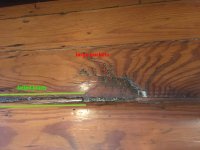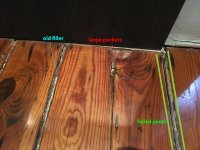With summer around the corner I'm looking to insulate under floors on a raised house. I do not own the house, but rent - my previous renovation accounted for as subsidized rent...I mention this because the floors will not be replaced entirely as the cost and mess for a project of this size is unthinkable given we just finished the renovation a year or so ago. I'm looking to stabilize the beautiful flooring that's left.
I live in hot/humid south Louisiana in a raised shotgun house. The filler used on the problem areas has since deteriorated due to expansion/contraction and been sucked up by the vacuum. The old heart pine t&g flooring has be refinished so many times, the joints in many areas have failed and split (ground below even visible in areas). The fasteners (whether sanded or rusted) have surely broken free in areas further exacerbating the problem.
My approach is to fasten treated ply between joist under the flooring to help with the differential, fasten flooring with stainless fasteners. The other two issues at hand - (1) the outer t&g joints and (2) larger "pockets" due to water/insect damage. These old shotgun houses were meant to breath, is there a recommended typical product, less brittle, that can flex between the joints (similar to caulk used on teak boat decking but without the mess? Note heavy sanding after drying may worsen the condition of the floors...as for the larger spits, is there a product similar to hydraulic cement which could be injected into pockets to fill the void between the new subfloor beneath?
I'm at a standstill. In my mind the individual boards need to be separated to deal with expansion/contraction. If the floor is too rigid and tight, filled with glue/other the problem will continue. I'm just looking for a short term stabilizing solution, maybe in a few years replace the floor.
I live in hot/humid south Louisiana in a raised shotgun house. The filler used on the problem areas has since deteriorated due to expansion/contraction and been sucked up by the vacuum. The old heart pine t&g flooring has be refinished so many times, the joints in many areas have failed and split (ground below even visible in areas). The fasteners (whether sanded or rusted) have surely broken free in areas further exacerbating the problem.
My approach is to fasten treated ply between joist under the flooring to help with the differential, fasten flooring with stainless fasteners. The other two issues at hand - (1) the outer t&g joints and (2) larger "pockets" due to water/insect damage. These old shotgun houses were meant to breath, is there a recommended typical product, less brittle, that can flex between the joints (similar to caulk used on teak boat decking but without the mess? Note heavy sanding after drying may worsen the condition of the floors...as for the larger spits, is there a product similar to hydraulic cement which could be injected into pockets to fill the void between the new subfloor beneath?
I'm at a standstill. In my mind the individual boards need to be separated to deal with expansion/contraction. If the floor is too rigid and tight, filled with glue/other the problem will continue. I'm just looking for a short term stabilizing solution, maybe in a few years replace the floor.



